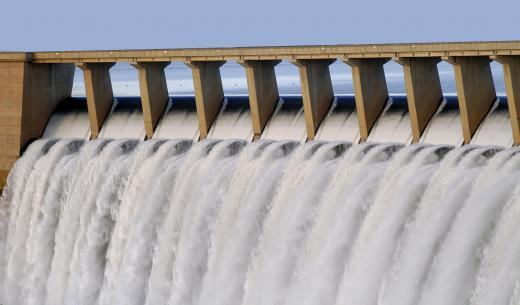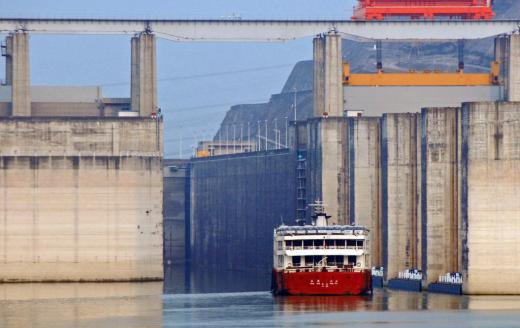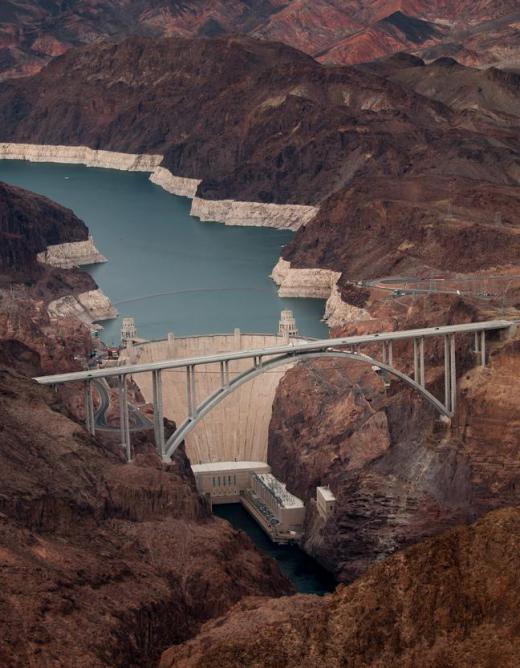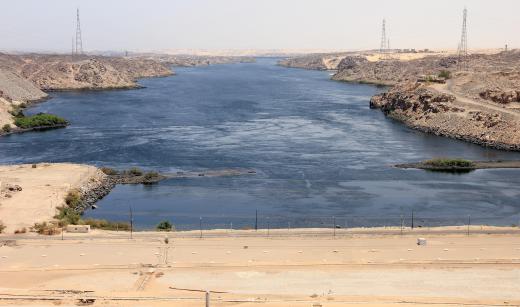What is Hydroelectric Power?
 Mary McMahon
Mary McMahon
Hydroelectric power (HEP), or hydroelectricity, is electrical power that is generated through the energy of flowing water. It has the advantage of using only renewable resources, and not producing harmful waste or byproducts, and is therefore viewed by many as an environmentally friendly alternative to the burning of fossil fuels that still provides the bulk of the electricity consumed throughout the world. HEP schemes, however, often meet with considerable opposition on the grounds that they cause major environmental problems of their own.
Principle

People have been harnessing the energy of moving water for centuries. In Ancient Greece and China, waterwheels were installed in rapidly flowing rivers to turn millstones and other equipment, and they continue to be used today in some parts of the world. In effect, these devices are using gravity, as water flows from a higher to a lower area.
Hydroelectric power plants rely on the same basic principle, but instead of using the kinetic energy directly, the force of the water drives a turbine which in turn powers a generator, producing electricity which can be used on-site or transported to other regions. As with other turbine-powered methods of generating electricity, magnets in the turbine move relative to static conductors. This results in an electrical current flowing through the conductors.

There are a number of different designs for hydroelectric power plants, but the most common one involves constructing a large dam across a lake at a relatively high elevation to form a reservoir of water, and allowing water to flow from it, in a controlled way, downhill to the generator, which is located at a lower elevation. The flow of water can be maximized at periods of high demand for electricity, and reduced when demand is lower. In most cases, the water is replenished by rainfall, but some power plants may use excess electricity to pump water back up to the reservoir at times of low demand.
Advantages

The main advantages of hydroelectric power are that it is clean and renewable. Since it does not involve the burning of fossil fuels, such as coal, oil, and natural gas, it does not produce any emissions of harmful pollutants such as soot and sulfur dioxide. Equally importantly, it does not produce any carbon dioxide, the gas that causes the “greenhouse” effect and which is thought to be responsible for climate change, through power generation. It has the advantage over nuclear power that it does not generate dangerous waste products that present long-term disposal problems.

HEP is also renewable, in that it does not use a resource that is limited. While coal, oil, natural gas, and even, eventually, uranium, will run out, water is inexhaustible. Once the power station has been built, the water it requires is available at no cost, in contrast to the fuels that have to be extracted from the ground. The supply of water is continually renewed in most areas by rainfall, which in effect means that the Sun is providing the energy, as its heat evaporates water from the surface that falls as rain.
Disadvantages
Although HEP is clean and renewable, it is not necessarily environmentally friendly. Large-scale projects capable of providing significant amounts of electricity usually require the damming of lakes or rivers, with consequent flooding of large areas of land. This can result in people being displaced, and destruction of habitats. Drastic alterations to the flows of rivers can also have a profound impact on wildlife, ecosystems and, in some cases, agriculture. Migrating fish, such as salmon, may have their routes blocked by dams, although this can be mitigated by installing a fish ladder — a series of steps that fish are able to negotiate.
The locations that are most suitable for hydroelectric power schemes are often of great scenic beauty, and may lose some of their value due to new roads, pylons, and other constructions associated with an HEP project. Some projects have had unintended consequences. For example, the Aswan dam in Egypt, which was very successful in providing power, also controlled the annual flooding of the river Nile downstream. This was at first thought to be another advantage, but the floods had been laden with nutrient-rich silt which made it possible to farm along the Nile, and once the dam was installed, all of that silt collected uselessly in the reservoir, depriving the land downstream of necessary nutrients. Another possible problem, according to some studies, is that decaying vegetation in areas flooded to provide HEP may give off significant amounts of carbon dioxide, offsetting the advantages of clean power generation.
AS FEATURED ON:
AS FEATURED ON:














Discussion Comments
Can hydro power can be used in ships?
The main problem was that they had made all the rivers straight and clean edged, leaving the salmon with no habitat, and they had put dams in all over the place, blocking the fish from returning to their spawning grounds.
So, they've done several different things to help, including putting in salmon ladders so that the fish can climb the dams, and even trucking the fish from one side of the dam to the other.
I just hope that they manage to really accomplish this, because it would be a real shame to lose the salmon for good.
For example, the Three Gorges Dam in China flooded an enormous area, including many villages that had to move, in order to create the reservoir that keeps the hydroelectric power turbines working. And the river below the dam is now much smaller than it once was.
I don't know any details about how it's disrupted the wildlife, but you can be sure it has.
Next stop was a museum with a lot of different exhibits on pioneers, including on where they had a small water wheel attached to a saw for cutting wood. They had life-sized manikins tending to the saw.
I explained again about how the water wheel was "powering" the saw, simply by being attached to it and my nephew was immediately very concerned. "Won't it electrocute those men?" He asked.
Kids can be very clever sometimes. Other times they can be too clever for their own good!
What exactly are the kind of things that make this a good or bad electricity method?
So is hydropower chemical, nuclear, motion, thermal or radiant?
@ Babalaas- What you said highlights the fundamental difference between conservation and preservation. Conservationists look to create sustainable use of environmental resources; preservationists advocate completely blocking access to the local environment.
I believe that a hydroelectric operation that does all it can to conserve the local environment is acceptable. This includes things like fish ladders and a decommissioning plan to restore the habitat when the plant becomes outdated. I also believe that regardless of the environmental impact of hydroelectric power generation, if given a choice between hydroelectric and coal generated electricity, I would choose hydroelectric.
Coal causes more damage to the environment than any other form of electricity. Hydroelectric power generation is also only suitable for certain areas. If you block that energy source from development, some other electricity generation option will be necessary. The odds are that option is coal or natural gas.
The article did a good job pointing out the benefits and costs of hydroelectric power generation. My opinion on the argument that hydroelectric power generation is destructive to the environment is the argument is narrow-minded.
Do not get me wrong, I am all for protecting the environment, but you must look at the bigger picture. The damage done by fossil fuels greatly outweighs the damage done by hydroelectric energy. Hydroelectric may alter landscapes (just as natural processes), but they do not cause the extinction of species (however, acid rain does). Every power generation technique used today has a downside. Whether the impact is economic, environmental, or social you cannot have cause without consequence.
Post your comments